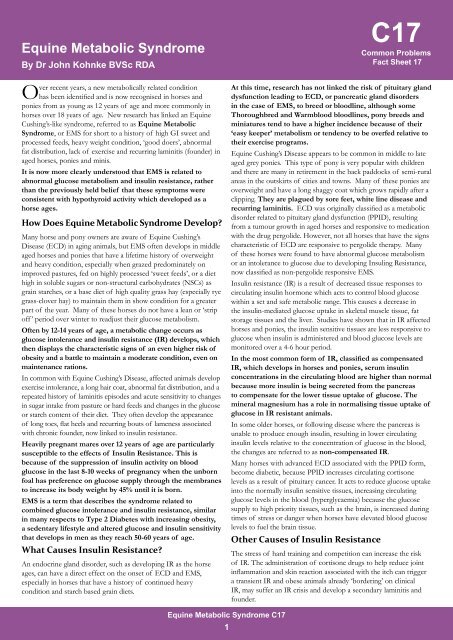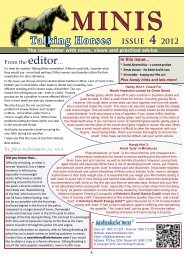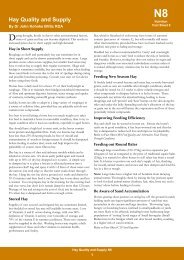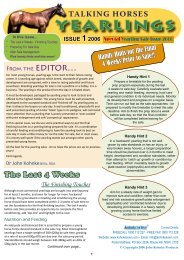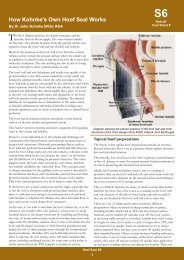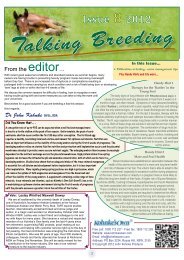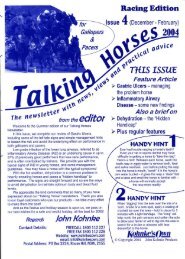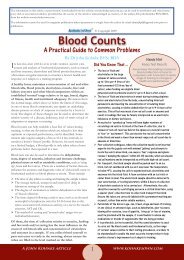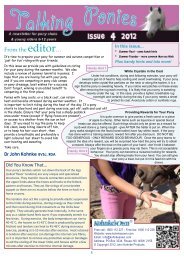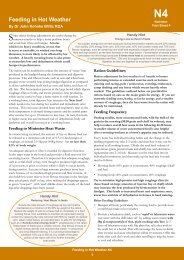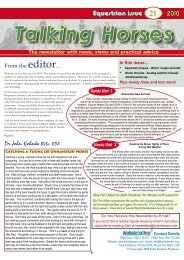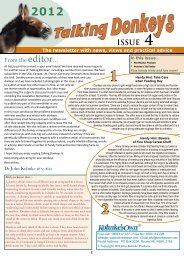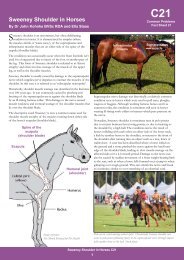Equine Metabolic Syndrome - Kohnke's Own
Equine Metabolic Syndrome - Kohnke's Own
Equine Metabolic Syndrome - Kohnke's Own
Create successful ePaper yourself
Turn your PDF publications into a flip-book with our unique Google optimized e-Paper software.
<strong>Equine</strong> <strong>Metabolic</strong> <strong>Syndrome</strong><br />
By Dr John Kohnke BVSc RDA<br />
Over recent years, a new metabolically related condition<br />
has been identified and is now recognised in horses and<br />
ponies from as young as 12 years of age and more commonly in<br />
horses over 18 years of age. New research has linked an <strong>Equine</strong><br />
Cushing’s-like syndrome, referred to as <strong>Equine</strong> <strong>Metabolic</strong><br />
<strong>Syndrome</strong>, or EMS for short to a history of high GI sweet and<br />
processed feeds, heavy weight condition, ‘good doers’, abnormal<br />
fat distribution, lack of exercise and recurring laminitis (founder) in<br />
aged horses, ponies and minis.<br />
It is now more clearly understood that EMS is related to<br />
abnormal glucose metabolism and insulin resistance, rather<br />
than the previously held belief that these symptoms were<br />
consistent with hypothyroid activity which developed as a<br />
horse ages.<br />
How Does <strong>Equine</strong> <strong>Metabolic</strong> <strong>Syndrome</strong> Develop?<br />
Many horse and pony owners are aware of <strong>Equine</strong> Cushing’s<br />
Disease (ECD) in aging animals, but EMS often develops in middle<br />
aged horses and ponies that have a lifetime history of overweight<br />
and heavy condition, especially when grazed predominately on<br />
improved pastures, fed on highly processed ‘sweet feeds’, or a diet<br />
high in soluble sugars or non-structural carbohydrates (NSCs) as<br />
grain starches, or a base diet of high quality grass hay (especially rye<br />
grass-clover hay) to maintain them in show condition for a greater<br />
part of the year. Many of these horses do not have a lean or ‘strip<br />
off ’ period over winter to readjust their glucose metabolism.<br />
Often by 12-14 years of age, a metabolic change occurs as<br />
glucose intolerance and insulin resistance (IR) develops, which<br />
then displays the characteristic signs of an even higher risk of<br />
obesity and a battle to maintain a moderate condition, even on<br />
maintenance rations.<br />
In common with <strong>Equine</strong> Cushing’s Disease, affected animals develop<br />
exercise intolerance, a long hair coat, abnormal fat distribution, and a<br />
repeated history of laminitis episodes and acute sensitivity to changes<br />
in sugar intake from pasture or hard feeds and changes in the glucose<br />
or starch content of their diet. They often develop the appearance<br />
of long toes, flat heels and recurring bouts of lameness associated<br />
with chronic founder, now linked to insulin resistance.<br />
Heavily pregnant mares over 12 years of age are particularly<br />
susceptible to the effects of Insulin Resistance. This is<br />
because of the suppression of insulin activity on blood<br />
glucose in the last 8-10 weeks of pregnancy when the unborn<br />
foal has preference on glucose supply through the membranes<br />
to increase its body weight by 45% until it is born.<br />
EMS is a term that describes the syndrome related to<br />
combined glucose intolerance and insulin resistance, similar<br />
in many respects to Type 2 Diabetes with increasing obesity,<br />
a sedentary lifestyle and altered glucose and insulin sensitivity<br />
that develops in men as they reach 50-60 years of age.<br />
What Causes Insulin Resistance?<br />
An endocrine gland disorder, such as developing IR as the horse<br />
ages, can have a direct effect on the onset of ECD and EMS,<br />
especially in horses that have a history of continued heavy<br />
condition and starch based grain diets.<br />
C17<br />
Common Problems<br />
Fact Sheet 17<br />
At this time, research has not linked the risk of pituitary gland<br />
dysfunction leading to ECD, or pancreatic gland disorders<br />
in the case of EMS, to breed or bloodline, although some<br />
Thoroughbred and Warmblood bloodlines, pony breeds and<br />
miniatures tend to have a higher incidence because of their<br />
‘easy keeper’ metabolism or tendency to be overfed relative to<br />
their exercise programs.<br />
<strong>Equine</strong> Cushing’s Disease appears to be common in middle to late<br />
aged grey ponies. This type of pony is very popular with children<br />
and there are many in retirement in the back paddocks of semi-rural<br />
areas in the outskirts of cities and towns. Many of these ponies are<br />
overweight and have a long shaggy coat which grows rapidly after a<br />
clipping. They are plagued by sore feet, white line disease and<br />
recurring laminitis. ECD was originally classified as a metabolic<br />
disorder related to pituitary gland dysfunction (PPID), resulting<br />
from a tumour growth in aged horses and responsive to medication<br />
with the drug pergolide. However, not all horses that have the signs<br />
characteristic of ECD are responsive to pergolide therapy. Many<br />
of these horses were found to have abnormal glucose metabolism<br />
or an intolerance to glucose due to developing Insuling Resistance,<br />
now classified as non-pergolide responsive EMS.<br />
Insulin resistance (IR) is a result of decreased tissue responses to<br />
circulating insulin hormone which acts to control blood glucose<br />
within a set and safe metabolic range. This causes a decrease in<br />
the insulin-mediated glucose uptake in skeletal muscle tissue, fat<br />
storage tissues and the liver. Studies have shown that in IR affected<br />
horses and ponies, the insulin sensitive tissues are less responsive to<br />
glucose when insulin is administered and blood glucose levels are<br />
monitored over a 4-6 hour period.<br />
In the most common form of IR, classified as compensated<br />
IR, which develops in horses and ponies, serum insulin<br />
concentrations in the circulating blood are higher than normal<br />
because more insulin is being secreted from the pancreas<br />
to compensate for the lower tissue uptake of glucose. The<br />
mineral magnesium has a role in normalising tissue uptake of<br />
glucose in IR resistant animals.<br />
In some older horses, or following disease where the pancreas is<br />
unable to produce enough insulin, resulting in lower circulating<br />
insulin levels relative to the concentration of glucose in the blood,<br />
the changes are referred to as non-compensated IR.<br />
Many horses with advanced ECD associated with the PPID form,<br />
become diabetic, because PPID increases circulating cortisone<br />
levels as a result of pituitary cancer. It acts to reduce glucose uptake<br />
into the normally insulin sensitive tissues, increasing circulating<br />
glucose levels in the blood (hyperglycaemia) because the glucose<br />
supply to high priority tissues, such as the brain, is increased during<br />
times of stress or danger when horses have elevated blood glucose<br />
levels to fuel the brain tissue.<br />
Other Causes of Insulin Resistance<br />
The stress of hard training and competition can increase the risk<br />
of IR. The administration of cortisone drugs to help reduce joint<br />
inflammation and skin reaction associated with the itch can trigger<br />
a transient IR and obese animals already ‘bordering’ on clinical<br />
IR, may suffer an IR crisis and develop a secondary laminitis and<br />
founder.<br />
<strong>Equine</strong> <strong>Metabolic</strong> <strong>Syndrome</strong> C17
Insulin resistance increases naturally during the last 70<br />
days of pregnancy in a mare as more glucose is delivered<br />
through the membranes, unaffected by the action of insulin,<br />
to provide the energy needed to fuel the very high rate of<br />
development where the unborn foal increases its body weight<br />
by 45% in the last 2-3 months before foaling.<br />
Obesity and Insulin Resistance<br />
Although IR is a metabolic consequence of obesity in horses and<br />
ponies, in older horses gaining weight due to high energy rations<br />
and a more sedentary lifestyle during retirement, weight control by<br />
dietary management to reduce starch and NSC intake, including<br />
limiting pasture grazing when plants are in their early, rapid phase<br />
of growth after rain or irrigation, must be instigated before the<br />
horse becomes obese and progresses to clinical IR.<br />
However, some IR horses may not be overly fat or obese, but<br />
as a consequence of developing IR, they may progress to<br />
clinical IR with signs of abnormal fat distribution, such as a<br />
‘cresty’ neck, fat pads around the tail base (butt), bulging fat<br />
deposits above the eyes and increased soft pads of fat behind<br />
the shoulders and under the belly. Normally the development<br />
of a ‘cresty’ neck is one of the most characteristic signs of<br />
early IR in otherwise reasonably conditioned and healthy<br />
animals.<br />
Exercise and Dietary Management<br />
<strong>Equine</strong> <strong>Metabolic</strong> Sydrome (EMS), unlike the other similar<br />
Cushing’s-like symptoms related to a pituitary gland cancer, can be<br />
effectively controlled by a combination of limiting grazing and hard<br />
feed restriction and daily exercise.<br />
The aim of dietary control is to reduce body fat mass and<br />
abnormal fat distribution so as to improve insulin sensitivity,<br />
by selecting ‘low glycaemic’ feeds (GI), combined with<br />
other dietary measures and increased, but not excessively<br />
hard exercise that would otherwise increase blood glucose<br />
responses.<br />
Careful management will also reduce the progression to laminitis<br />
and founder in clinically IR horses and overweight ponies.<br />
Obviously in PPID horses with developing ECD, pergolide<br />
therapy should be used in conjunction with dietary and exercise<br />
management to control IR and its clinical symptoms. This will<br />
help normalise metabolic function and in most cases, improve the<br />
horse’s lifestyle for 3-5 years until the severity of PPID becomes<br />
non-responsive to pergolide therapy.<br />
1.<br />
2.<br />
3.<br />
Restriction of pasture access to 1-2 hours total per day.<br />
Keep pastures short and if necessary purchase a grazing muzzle<br />
so that the horse or pony can exercise without consuming<br />
too much ‘sugary’ (non-structural carbohydrate NSC) grass,<br />
especially rye grass based pasture in its early dynamic phase of<br />
growth in early Spring, or a growth flush following late summer<br />
or early autumn rains, which often cause an increase in the risk<br />
of laminitis due to excess fructan or NSC carbohydrate intake as<br />
a result of unrestricted grazing<br />
Ensure a regular exercise program - daily walks for 15-20<br />
minutes without grazing to utilise excess blood glucose.<br />
Controlled intake of NSC sugars in hard feeds and hay,<br />
especially good quality grass hay which was early growth phase<br />
pasture before being cut and cured as hay, as it can be even<br />
more dangerous in small amounts as dehydrated pasture in the<br />
same way that it was as rapidly growing, high NSC yielding, lush<br />
grazing pasture.<br />
Chosoe low GI or low NSC feeds by avoiding cereal grain based<br />
pellets, sweet grain mixes or grain based extruded feeds. Feed<br />
<strong>Equine</strong> <strong>Metabolic</strong> <strong>Syndrome</strong> C17<br />
<br />
restricted amounts of millrun based equestrian pellets, rice bran<br />
(it too contains 20% NSCs) and even copra meal. Feeding Omega<br />
balanced vegetable oil blends (oils are very low or zero GI feeds) at<br />
a rate of up to 5% by weight of the ration, introduced in a stepwise<br />
manner over 10-14 days, will help ensure efficient digestion<br />
and reduce blood sugar levels as a part replacement for grain or<br />
high GI feeds. Ideally, the daily hard feed and hay should be split<br />
into 2-3 meals, with some during the day to avoid a large meal,<br />
especially at night, which can lead to a higher glucose peak and<br />
compensatory IR. Low GI feed products such as Equi-Jewel® and<br />
Rebuild® are also recommended, but it is important to feed only<br />
the amounts recommended, preferably split between 2-3 feeds.<br />
This is also important when feeding other commercial feeds that<br />
are recommended to help avoid laminitis and founder, especially to<br />
over-weight horses with classical symptoms of IR.<br />
Suitable roughages include hay which has been soaked in<br />
double its volume of warm water for 60 minutes and then<br />
taken out to drain and air dry before feeding. As a part or full<br />
substitute for oaten chaff, feeding 5% of the total ration weight<br />
of dry sugar beet fibre and then soaking it for 10 minutes before<br />
feeding to supply low GI, highly digested fibre or 10-15% by<br />
weight of lupin or soyabean hulls, will help to minimise the glucose<br />
peak after feeding. Remember that sugar beet fibre contains some<br />
NSC - so avoid large single feeds, especially in overweight horses<br />
and ponies. Good quality oaten chaff has a higher GI and<br />
NSC content than an equivalent weight of lucerne chaff,<br />
with wheaten chaff having the lowest GI of chopped hay<br />
roughages.<br />
Supplementation with the product Kohnke’s <strong>Own</strong> TRIM,<br />
which by way of its magnesium content has a role in normalising<br />
blood sugar by facilitating glucose use by the tissues and thus<br />
lowering blood sugar and its direct effect on the level of circulating<br />
insulin which peaks after a meal. TRIM also contains organic<br />
chromium which has a role in mimicking the action of insulin in<br />
response to blood sugar elevation after a meal. It also contains<br />
choline and manganese which have roles in normal fat metabolism<br />
and regulation of fat build up in the crest and tail butt areas.<br />
TRIM is best given at double doses for 5-7 days or until the ‘crest’<br />
or tail butt deposits become soft, then reduce to a standard dose<br />
for another 5-7 days. After this time, it is a good idea to monitor<br />
the ‘hardness’ of the crest and tail butt area at 2-3 day intervals. If<br />
they again become packed HARD with sugars and fat, then<br />
reintroduce TRIM at double doses, as outlined above, until<br />
the crest and tail butt soften. The risk of a horse foundering due<br />
to EMS if the crest and tail butt area remains soft is much reduced.<br />
The addition of a supplement containing calcium, traceminerals,<br />
including organic zinc and chromium, and a full<br />
range of vitamins, such as Kohnke’s <strong>Own</strong> Cell-Provide®, as<br />
well as adequate salts, such as Kohnke’s <strong>Own</strong> Cell-Salts, will<br />
help maintain water intake and make up the shortfalls of water<br />
soluble nutrients and salts leached out by soaking hay when soaked<br />
hay is provided as a roughage base. These supplements, along<br />
with TRIM as required to maintain a ‘soft’ neck, have a role in<br />
maintaining metabolic function and vitality in IR affected horses.<br />
Research is continuing on other specific supplements that may help<br />
maintain metabolic function in horses prone to IR in retirement.<br />
Monitor your horse’s body weight every 5-7 days, but do not<br />
starve your horse, and particularly a pony or miniature, so<br />
that it will rapidly lose weight. Rapid weight reduction due<br />
to starvation can trigger fat mobilisation and the onset of a<br />
condition referred to as Hyperlipaemia in certain bloodlines<br />
of horses and ponies, which if not recognised early, can be<br />
fatal within 10-14 days.
Low GI Feeds Medium GI Feeds High GI Feeds<br />
Soyabean hulls<br />
Lupin hulls<br />
Sugar beet pulp (non molasses)<br />
Lupin seeds<br />
Soyabean meal<br />
Sunflower seeds<br />
Copra meal (small amounts)<br />
Vegetable oils<br />
Carrots - fresh<br />
Commercial Feeds:<br />
Very Low GI<br />
Speedi-Beet®<br />
Hygain Zero®<br />
Pryde’s EasiFibre®<br />
Maxisoy Low GI SuperFibre Pellets®<br />
Soaked lucerne hay (lowest roughage)<br />
Soaked grass and cereal Hay<br />
Wheat bran<br />
Wheat pollard<br />
Rice bran<br />
Millrun (small amounts 10% ration daily)<br />
Molasses<br />
Apples<br />
Pears<br />
Grass, clover and cereal Hay<br />
Commercial Feeds:<br />
High GI<br />
Micronised Feeds<br />
Extruded Feeds<br />
Mitavite Formula 3®<br />
Hygain Micrspeed®<br />
Most ‘performance’ feeds for<br />
racing and working horses, including<br />
grain mueslis or textured feeds with<br />
molasses.<br />
The photo at right<br />
shows hard tail butt<br />
fat deposits on a<br />
pony that displays<br />
symptoms of <strong>Equine</strong><br />
<strong>Metabolic</strong> <strong>Syndrome</strong><br />
The information in this fact sheet, or part thereof, downloaded from the website www.kohnkesown.com,<br />
can be used in newsletters and other horse/pony club or association bulletins, provided that the source of<br />
the fact sheet is acknowledged as courtesy of the author, Dr. John Kohnke BVSc RDA, from the website<br />
www.kohnkesown.com. The information cannot be used for magazine publication unless permission is<br />
sought from the author by email info@kohnkesown.com prior to publication.<br />
<strong>Equine</strong> <strong>Metabolic</strong> <strong>Syndrome</strong> C17<br />
<br />
©Copyright 2013<br />
FREECALL 1800 112 227 - www.kohnkesown.com - email: info@kohnkesown.com


